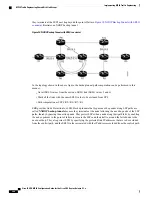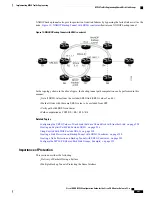
SUMMARY STEPS
1.
configure
2.
mpls traffic-eng
3.
interface type interface-path-id
4.
exit
5.
exit
6.
router ospf process-name
7.
area area-id
8.
exit
9.
mpls traffic-eng router-id ip-address
10.
Use the
commit
or
end
command.
11.
(Optional)
show mpls traffic-eng topology
12.
(Optional)
show mpls traffic-eng link-management advertisements
DETAILED STEPS
Purpose
Command or Action
Enters global configuration mode.
configure
Example:
RP/0/RP0/CPU0:router# configure
Step 1
Enters MPLS-TE configuration mode.
mpls traffic-eng
Example:
RP/0/RP0/CPU0:router(config)#
mpls traffic-eng
Step 2
RP/0/RP0/CPU0:router(config-mpls-te)#
Enables traffic engineering on a particular interface on the
originating node and enters MPLS-TE interface
configuration mode.
interface type interface-path-id
Example:
RP/0/RP0/CPU0:router(config-mpls-te)#
interface
Step 3
POS0/6/0/0
RP/0/RP0/CPU0:router(config-mpls-te-if)#
Exits the current configuration mode.
exit
Example:
RP/0/RP0/CPU0:router(config-mpls-te-if)#
exit
Step 4
RP/0/RP0/CPU0:router(config-mpls-te)#
Cisco IOS XR MPLS Configuration Guide for the Cisco CRS Router, Release 5.1.x
214
Implementing MPLS Traffic Engineering
Building MPLS-TE Topology






































